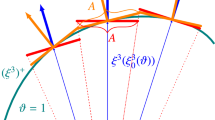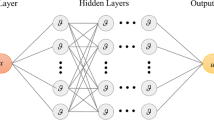Abstract
In this paper, a weak form quadrature element formulation of a geometrically nonlinear shell model is proposed and applied for analysis of laminated composite shell structures. Thickness stretch parameters of the shell are incorporated for introducing 3D constitutive relations in the formulation. A drilling rotation constraint on the basis of polar decomposition of a modified deformation gradient is enforced by the Lagrange multiplier method and employed for implementing spatial finite rotations. The present formulation is shown to be feasible to model complex structures and circumvent locking problems naturally. A series of numerical benchmark examples are presented to demonstrate the validity of the formulation.


















Similar content being viewed by others
References
Naghdi, P.M.: The theory of shells and plates. In: Truesdell, C. (ed.) Handbuch der Physik a/2, vol. 6, pp. 425–640. Berlin, Springer (1972)
MacNeal, R.H., Wilson, C.T., Harder, R.L., Hoff, C.C.: The treatment of shell normals in finite element analysis. Finite Elem. Anal. Des. 30, 235–242 (1998)
Brank, B., Korelc, J., Ibrahimberović, A.: Nonlinear shell formulation accounting for through-the-thickness stretching and its finite element implementation. Comp. Struct. 80, 699–717 (2002)
Simo, J.C., Rifai, M.S., Fox, D.D.: On a stress resultant geometrically exact shell model. Part IV: variable thickness shells with through-the-thickness stretching. Comp. Methods. Appl. Mech. Eng. 81, 91–126 (1990)
Büchter, N., Ramm, E., Roehl, D.: Three-dimensional extension of non-linear shell formulation based on the enhanced assumed strain concept. Int. J. Numer. Meth. Eng. 37, 2551–2568 (1994)
Braun, M., Bischoff, M., Ramm, E.: Nonlinear shell formulations for complete three-dimensional constitutive laws including composites and laminates. Comput. Mech. 15, 1–18 (1994)
Sansour, C.: A theory and finite element formulation of shells at finite deformations involving thickness change: circumventing the use of a rotation tensor. Arch. Appl. Mech. 65, 194–216 (1995)
Brank, B.: Nonlinear shell models with seven kinematic parameters. Comp. Methods. Appl. Mech. Eng. 194, 2336–2362 (2005)
Payette, G.S., Reddy, J.N.: A seven-parameter spectral/hp finite element formulation for isotropic, laminated composite and functionally graded shell structures. Comp. Methods. Appl. Mech. Eng. 278, 664–704 (2014)
Yamamoto, T., Yamada, T., Matsui, K.: A quadrilateral shell element with degree of freedom to represent thickness-stretch. Comput. Mech. 59, 625–646 (2017)
Leonetti, L., Liguori, F., Magisano, D., Garcea, G.: An efficient isogeometric solid-shell formulation for geometrically nonlinear analysis of elastic shells. Comp. Methods. Appl. Mech. Eng. 331, 159–183 (2018)
Allman, D.J.: A compatible triangular element including vertex rotations for plane elasticity problems. Comp. Struct. 19, 1–8 (1984)
Hughes, T.J.R., Brezzi, f: On drilling degrees of freedom. Comp. Methods. Appl. Mech. Eng. 72, 105–121 (1989)
Kugler, S., Fotiu, P.A., Murin, J.: A highly efficient membrane finite element with drilling degrees of freedom. Acta. Mech. 213, 323–348 (2010)
Fox, D.D., Simo, J.C.: A drill rotation formulation for geometrically exact shells. Comput. Methods. Appl. Mech. Eng. 98, 329–343 (1992)
Rebel, G.: Finite Rotation Shell Theory Including Drill Rotations and Its Finite Element Implementations. Phd dissertation, Delft University of Technology (1998)
Chróścielewski, J., Makowski, J., Stumpf, H.: Genuinely resultant shell finite elements accounting for geometric and material non-linearity. Int. J. Numer. Methods. Eng. 35, 63–94 (1992)
Chróścielewski, J., Kreja, I., Sabik, A., Witkowski, W.: Modeling of composite shells in 6-parameter nonlinear theory with drilling degree of freedom. Mech. Adv. Mater. Struct. 18, 403–419 (2011)
Chróścielewski, J., Sabik, A., Sobczyk, B., Witkowski, W.: Nonlinear FEM 2D failure onset prediction of composite shells based on 6-parameter shell theory. Thin Wall. Struct. 105, 207–219 (2016)
Yang, Y.B., Chang, J.T., Yau, J.D.: A simple nonlinear triangular plate element and strategies of computation for nonlinear analysis. Comp. Meth. in Appl. Mech. Eng. 178, 307–321 (1999)
Yang, Y.B., Lin, S.P., Chen, C.S.: Rigid body concept for geometric nonlinear analysis of 3D frames, plates and shells based on the updated Lagrangian formulation. Comp. Meth. in Appl. Mech. Eng. 196(7), 1178–1192 (2007)
Yang, Y.B., Lin, S.P., Leu, L.J.: Solution strategy and rigid element for nonlinear analysis of elastic structures based on updated Lagrangian formulation. Eng. Struct. 29(6), 1189–1200 (2007)
Yang, Y.B., Lin, S.P., Wang, C.M.: Rigid element approach for deriving the geometric stiffness of curved beams for use in buckling analysis. J. Struct. Eng., ASCE 133(12), 1762–1771 (2007)
Zhong, H., Yu, T.: Flexural vibration analysis of an eccentric annular Mindlin plate. Arch. Appl. Mech. 77(4), 185–195 (2007)
Zhong, H., Yu, T.: A weak form quadrature element method for plane elasticity problems. Appl. Math. Model. 33(10), 3801–3814 (2009)
Bellman, R.E., Casti, J.: Differential quadrature and long term integration. J. Math. Anal. Appl. 34, 235–238 (1971)
Striz, A.G., Chen, W.L., Bert, C.W.: Static analysis of structures by the quadrature element method (QEM). Int. J. Solids Struct. 31(20), 2807–2818 (1994)
Zhong, H., Zhang, R., Xiao, N.: A quaternion-based weak form quadrature element formulation for spatial geometrically exact beams. Arch. Appl. Mech. 84(12), 1825–1840 (2014)
Zhang, R., Zhong, H.: Weak form quadrature element analysis of geometrically exact shells. Int. J. Non-linear Mech. 71, 63–71 (2015)
Zhang, R., Zhong, H.: A weak form quadrature element formulation for geometrically exact thin shell analysis. Comp. Struct. 202, 44–59 (2018)
He, R., Zhong, H.: Large deflection of elasto-plastic analysis of frames using the weak form quadrature element method. Finite Elem. Anal. Des. 509, 125–133 (2012)
Jelenić, G., Crisfield, M.A.: Geometrically exact 3D beam theory: implementation of strain-invariant finite element for statics and dynamics. Comp. Methods. Appl. Mech. Eng. 171, 141–171 (1999)
Zhang, R., Zhong, H.: A weak form quadrature element formulation of geometrically exact shells incorporating drilling degrees of freedom. Comput. Mech. 63, 663–679 (2019)
Carrera, E.: Theories and finite elements for multilayered, anisotropic, composite plates and shells. Arch. Comput. Meth. Eng. 9(2), 87–140 (2002)
Reddy, J.N.: Mechanics of Laminated Composite Plates and Shells: Theories and Analysis, 2nd edn. CRC Press, Boca Raton (2004)
Crisfield, M.A.: Non-linear finite element analysis of solids and structures: volume 2: advanced topics. Wiley, West Sussex (1997)
Davis, P.I., Rabinowitz, P.: Methods of Numerical Integration, 2nd edn. Academic Press, Orlando (1984)
Knight, N.F.: The Raasch challenge for shell elements. AIAA J. 75, 237–250 (1997)
ABAQUS, Version 6.14., 2014. Dassault Systèmes Simulia Corp., Providence, RI, USA
Sze, K.Y., Liu, X.H., Lo, S.H.: Popular benchmark problems for geometric nonlinear analysis of shells. Finite Elem. Anal. Des. 40, 1551–1569 (2004)
Wardle, B.L.: Solution to the incorrect benchmark shell-buckling problem. AIAA J. 46(2), 381–387 (2008)
Zhou, Y., Stanciulescu, I., Eason, T., Spottswood, M.: Nonlinear elastic buckling and postbuckling analysis of cylindrical panels. Finite Elem. Anal. Des. 96, 41–50 (2015)
Stanić, A., Brank, B., Korelc, J.: On path-following methods for structural failure problems. Comput. Mech. 58, 281–306 (2016)
Basar, Y., Ding, Y.H.: Finite-rotation elements for the non-linear analysis of thin shell structures. Int. J. Solids. Struct. 26(1), 83–97 (1990)
Simo, J.C.: On a stress resultant geometrically exact shell model. Part VII: shell intersections with 5/6-DOF finite element formulations. Comp. Methods. Appl. Mech. Eng. 108, 319–339 (1993)
Li, Z., Li, T., Vu-Quoc, L., Izzuddin, B.A., Zhuo, X., Fang, Q.: A nine-node corotational curved quadrilateral shell element for smooth, folded, and multishell structures. Int. J. Numer. Methods. Eng. 116, 570–600 (2018)
Talbot, M., Dhatt, G.: Three discrete Kirchhoff elements for shell analysis with large geometrical non-linearities and bifurcations. Eng. Comput. 4, 15–22 (1987)
Chróścielewski, J., Makowski, J., Stumpf, H.: Finite element analysis of smooth, folded and multi-shell structures. Comp. Methods. Appl. Mech. Eng. 141, 1–46 (1997)
Acknowledgements
The present investigation was performed with the support of the National Natural Science Foundation of China (No. 11702098), the Fundamental Research Funds for the Central Universities (2019MS122) and the China Scholarship Council (201906155033).
Author information
Authors and Affiliations
Corresponding author
Additional information
Publisher's Note
Springer Nature remains neutral with regard to jurisdictional claims in published maps and institutional affiliations.
Appendix: Expression of element tangent stiffness matrix
Appendix: Expression of element tangent stiffness matrix
The element tangent stiffness matrix \(\mathbf{K }^{(e)}\) consists of three parts corresponding to \(\mathbf {G}_{\mathrm{int}}^{(e)} \), \(\mathbf {G}_{\mathrm{ext}}^{(e)} \) and \(\mathbf {G}_{c}^{(e)} \) in the element residual force vector as
The element internal tangent stiffness matrix can be derived from Eq. (56) as
The expressions of matrices \(\varvec{\Xi }^{(k+l)}\) are
and

with the sub-matrices
and
With the definition of the vector
the matrix \(\varvec{\Gamma }_{ij}^{(k+l)} \) is written as
where
with \(\mathbf {v}_{(i)}^{(k+l)}\) being the \(i\hbox {th}\) term of \(\mathbf {v}^{(k+l)}\).
By defining the following matrices
the element external tangent stiffness matrix has the form
The element tangent stiffness derived from the kinematic constraint term is presented as
with the matrix
The sub-matrices in Eq. (A.17) are
where
Rights and permissions
About this article
Cite this article
Zhang, R., Zhong, H., Yao, X. et al. A quadrature element formulation of geometrically nonlinear laminated composite shells incorporating thickness stretch and drilling rotation. Acta Mech 231, 1685–1709 (2020). https://doi.org/10.1007/s00707-019-02606-5
Received:
Revised:
Published:
Issue Date:
DOI: https://doi.org/10.1007/s00707-019-02606-5




